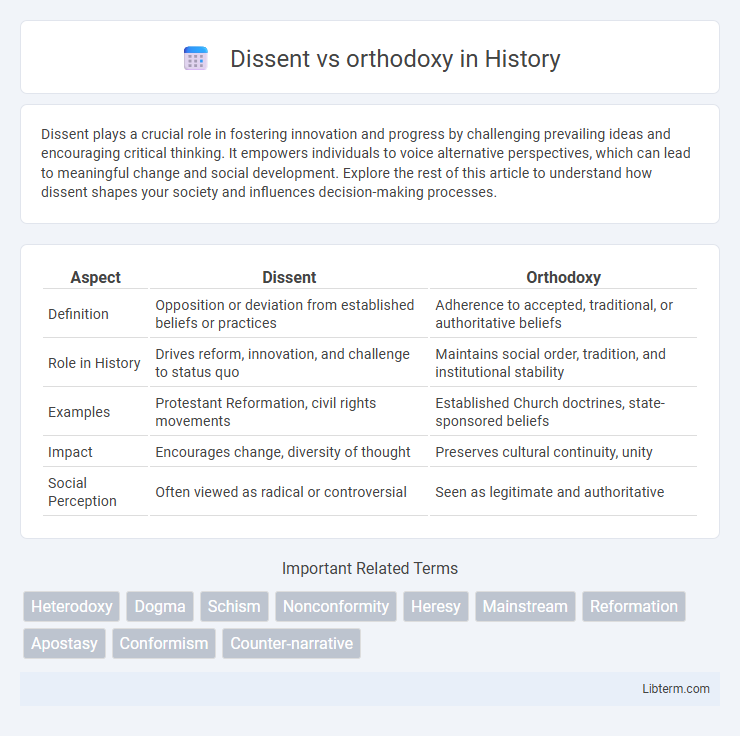Dissent plays a crucial role in fostering innovation and progress by challenging prevailing ideas and encouraging critical thinking. It empowers individuals to voice alternative perspectives, which can lead to meaningful change and social development. Explore the rest of this article to understand how dissent shapes your society and influences decision-making processes.
Table of Comparison
| Aspect | Dissent | Orthodoxy |
|---|---|---|
| Definition | Opposition or deviation from established beliefs or practices | Adherence to accepted, traditional, or authoritative beliefs |
| Role in History | Drives reform, innovation, and challenge to status quo | Maintains social order, tradition, and institutional stability |
| Examples | Protestant Reformation, civil rights movements | Established Church doctrines, state-sponsored beliefs |
| Impact | Encourages change, diversity of thought | Preserves cultural continuity, unity |
| Social Perception | Often viewed as radical or controversial | Seen as legitimate and authoritative |
Defining Dissent and Orthodoxy
Dissent refers to the expression of opinions or beliefs that diverge from established norms or official positions, often challenging accepted doctrines within religious, political, or social contexts. Orthodoxy denotes adherence to accepted or traditional beliefs, practices, and doctrines that are widely recognized as authoritative and correct. The distinction between dissent and orthodoxy is crucial in understanding conflicts within institutions and societies where ideological conformity is enforced.
Historical Contexts of Dissent and Orthodoxy
Historical contexts of dissent and orthodoxy reveal the dynamic tensions between established doctrines and revolutionary ideas across different eras. In religious, political, and social spheres, orthodox beliefs often solidified state or institutional power, while dissent challenged these paradigms to foster reform or revolution, as seen in events like the Protestant Reformation and the Enlightenment. The clash between dissenters and orthodox authorities shaped legal frameworks, cultural norms, and intellectual progress throughout history.
Key Differences Between Dissent and Orthodoxy
Dissent involves expressing disagreement or opposition to established beliefs or practices, whereas orthodoxy represents adherence to traditional and accepted doctrines within a community or institution. Dissent often challenges the status quo, promoting reform or alternative viewpoints, while orthodoxy emphasizes conformity and preservation of established norms. These differences highlight the dynamic tension between innovation and tradition in cultural, religious, and political contexts.
The Role of Dissent in Social Progress
Dissent challenges prevailing orthodoxies by questioning established norms and promoting critical debate, which drives innovation and social reform. Historical examples such as the civil rights movement illustrate how dissent catalyzes legal and cultural transformations, expanding freedoms and equality. Societies that tolerate and encourage dissent often experience accelerated progress through increased pluralism and resilience against stagnation.
Orthodoxy as a Pillar of Stability
Orthodoxy serves as a foundational pillar of stability by preserving established beliefs and promoting social cohesion within communities. Its adherence to traditional values and doctrines provides a consistent framework that guides moral behavior and institutional practices. This continuity mitigates societal disruptions and supports orderly governance by maintaining a shared understanding of norms and principles.
Famous Examples of Dissent Challenging Orthodoxy
Galileo Galilei's advocacy for heliocentrism fundamentally challenged the prevailing geocentric orthodoxy of the Catholic Church, illustrating the profound impact of dissent on scientific progress. Similarly, Martin Luther's 95 Theses directly confronted the Catholic Church's practices, sparking the Protestant Reformation and reshaping religious orthodoxy in Europe. In the realm of civil rights, figures like Rosa Parks defied racial segregation laws, exemplifying dissent as a catalyst for social justice and systemic change.
The Risks and Consequences of Dissent
Dissent challenges established orthodoxy, often risking social ostracism, professional setbacks, and legal repercussions. Historical examples reveal how dissenters face censorship, imprisonment, or exile for opposing dominant ideologies or state policies. The consequences extend to personal and collective spheres, affecting freedom of expression and societal progress.
How Orthodoxy Responds to Dissent
Orthodoxy responds to dissent by reinforcing established doctrines through institutional authority and theological reaffirmation, emphasizing conformity to core beliefs to maintain unity. Mechanisms such as excommunication, doctrinal condemnation, and educational control are employed to discourage deviations and preserve canonical teachings. This response aims to protect the integrity of religious traditions against doctrinal fragmentation and heterodoxy.
The Balance Between Dissent and Conformity
The balance between dissent and conformity is crucial for fostering innovation while maintaining social cohesion. Dissent drives progress by challenging orthodox beliefs and encouraging critical thinking, whereas conformity ensures stability and collective identity within societies. Effective systems integrate diverse viewpoints without undermining shared values, promoting adaptive flexibility in cultural and organizational environments.
Future Trends: Evolving Norms of Dissent and Orthodoxy
Future trends indicate a growing acceptance of dissent within traditionally orthodox institutions, driven by increased digital communication and global interconnectedness. Emerging platforms enable diverse voices to challenge established norms, fostering a dynamic interplay between innovation and tradition. This evolution suggests orthodoxy will become more adaptive, integrating dissent as a catalyst for progress rather than a threat to stability.
Dissent Infographic

 libterm.com
libterm.com